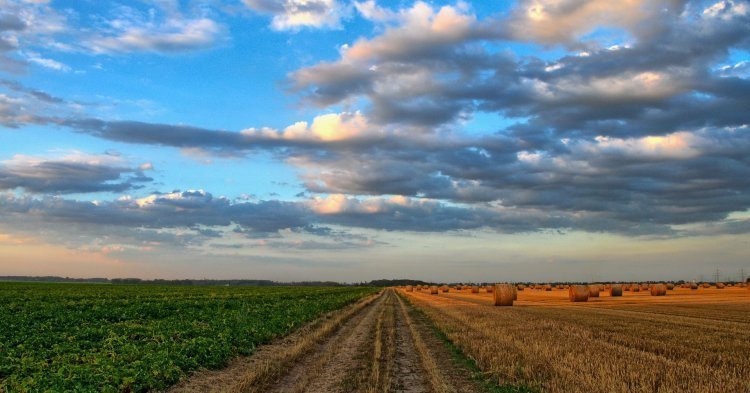Advocacy for sustainable agriculture
Sustainable agriculture is often reduced to the idea of an environmentally friendly agriculture. Yet, the notion is broader and also covers social and economic aspects.
Let’s start with the approach of the French researchers Olivier Godard and Bernard Hubert. They define two axes of sustainability for agriculture. They recall that sustainable agriculture is spread over time, with a self-centred and necessarily viable sustainability, meaning an ability to finance its own needs without compromising those of future generations, but also ability to face hazards.
To this end, natural resources (air, water, soil) must be preserved. The cultivated or grazed field then enters into an agroecosystem. Human influences (cultivation, inputs etc) must deal with with the elements of this system, such as the subsoil, the land, the flora or the transient fauna (insects, birds or wild animals). If it is not about opposing human activities to an alleged and often idealised “natural state”, these activities should not damage the agroecosystem, at the risk of generating losses of agricultural potential which could be irreversible.
However, the environmental aspect is not the only one to consider. One also has to consider stable and substitutable workforce, with available replacement in case of life’s uncertainties. The farm’s financial health must also enable to finance its operating cycle (i.e. the funding of the ordinary activities), to reimburse the new annuities linked to the renewal of capital and to pay the farmers according to their needs.
Godard and Hubert then define a second pillar of sustainability, gathering the durability of the externalities created by a farm. These externalities can be environmental, with capturing CO2 or landscape maintenance, or economic, with the jobs directly (e.g. suppliers, advisers) or indirectly (e.g. tourism) depending of agriculture, contributing to the life of rural territories.
Sustainability is a manifold concept which requires a systemic approach. However, sustainability is extremely useful and even necessary to any agricultural activity.
In economics, public authorities prefer short-term solutions
If people are better off prioritising sustainable solutions to satisfy their own interests, and by extension those of society, agricultural policies act in immediacy without caring about the sustainability of the induced effects. In 2016, a French farmer earned on average €32,100 in benefits, which represents a fifth of the products yielded by the farm. [1] However, one in two farmers earns less than the monthly net minimum wage.
The CAP succeeded at making the farms dependent on subsidies, without ensuring a sufficient remuneration for a great number of farmers. This short-term solution does not necessarily incite the farmers to reform their economic model, by trying new types of production, by diversifying or by grouping together to share the mechanisation and workforce costs.
Subsidies often form spin-off benefits. The farmers can modify their choices of crop rotation (use of agricultural land for a given crop season) according to announced coupled aid on one type of production or another. [2]
Let’ not forget that these benefits are ’constant envelopes’: if many farmers decide to subscribe to it, the denominator will increase, and the aid will be spread too thinly between the beneficiaries. This happened in 2017 with the aid coupled with the soybean production. This subsidy was a victim of its own success, because the eligible farmers gained only 40 euros per hectare, whereas many were expecting higher amounts. The farmers’ choices can thus sometimes come down to reactions to the announcements of price support. Without these announcements, they could have built their own strategic choices in collaboration with advisory structures.
Similarly, the CAP has countercyclical elements designed for compensating the market hazards. It is true that agricultural raw materials are part of the goods whose prices are the most fluctuating. However, interventions on the markets truncate and disturb the farmers’ behaviour, in particular their risk aversion. These farmers are essentially price-takers who do not fix the prices but take the market’s ones. [3] Instead of relying on the intervention of public authorities if prices are low, private and sustainable mechanisms exist, such as trainings on market understanding, private insurances and forward contracts. It’s not when the crisis comes that we have to find solutions: sustainable farming anticipates and has its own safety net, instead of trying to cling on to others’.
Public environmental policies are not necessarily sustainable
The French application of the CAP does not incentivise agroecology, but favours a complex and incomplete environmental policy.
First of all, the declaration made by the farmers in order to get their subsidies is only based on the present or upcoming cultivations for the current growing year. Adopting a pluriannual approach, taking the rotation into account, would be worth considering. Some cultivations can have advantages, both for the environment and for the next cultivations. For example, leguminous plants contain bacteria with the ability to capture nitrogen in the roots and to transform it into mineral nitrogen, assimilable by the plants’ roots. If the farmer cultivates a cereal after an alfalfa, they will need less artificial fertilisers. However, the CAP is based on a very short cycle, the one of the reporting year.
Then, the farmers must dedicate no less than 5% of the area they cultivate to Areas of Ecological Interest (AEI). [4] These areas can be unused (fences, ponds, etc.) or used (harvested buffer strips, plant covers, etc.). This ratio gives the impression that cultivated areas are opposed to “more natural” areas. If we refer to the definition of an agroecosystem mentioned earlier, every arable land could be likened to an AEI. This time again, CAP’s decision-makers do not think with the good scale: the conservation of the environment must not be summarised to a zoning between “green” and cultivated areas, but it must concern each parcel.
Finally, the CAP doesn’t consider soils, even though they provide great ecosystemic services. Three to four billion tonnes of carbon are estimated to be stored within the first 30 centimetres of French soils, essentially in grasslands and croplands. They also enable the infiltration of rainwaters, which helps protect against floods. Yet, different cultivation practices exist, and they don’t all have the same effects on the soil structure. Environmental subsidies take into account neither the straw landfills or plant covers which increase the level of organic matter, nor the impact of the settling caused by the material, nor the ploughing-free techniques enabling to save the soil’s microflora and macrofauna or to avoid the turnaround of the different ground layers. Yet, the durability of an agroecosystem goes through the preservation of its soil condition.
Sustainability is a notion which has to be grasped on different scales. By granting benefits and forgetting essential aspects of agroecosystem preservation, the CAP does not allow the farmers to adopt a long-term vision. Yet, sustainable agriculture comes from good sense, accountability, and above all from a certain rationality in terms of thinking about the securing, durability, and development of farming.




Follow the comments: |
|
